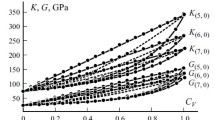Abstract
A mathematical model was constructed describing the thermomechanical interaction of particles of the composite matrix and reinforcing elements (randomly oriented anisotropic single-walled carbon nanotubes) with an isotropic medium with the desired thermoelastic characteristics. This model was used to find the self-consistency of the thermoelastic characteristics of the composite, taking into account the porosity of its matrix, which are compared with two-sided estimates derived from the dual variational formulation of the thermoelasticity problem. The presented relations make it possible to estimate the effect of the porosity of the matrix of the composite under consideration on its thermoelastic characteristics.
Similar content being viewed by others
References
J. Bieksha, “Utilization of Composite Materials in Defense and Aerospace Industries,” Vestn. Elektron., No. 1, 24–27 (2014).
Reference Book in Composite Materials, Ed. by J. Lubin (Mashinostroenie, Moscow, 1988) [in Russian].
V. V. Vasiliev, Mechanics of Structures Made of Composite Materials (Mashinostroenie, Moscow, 1988) [in Russian].
R. A. Roscoe, “Isotropic Composites with Elastic and Viscoelastic Phases: General Bounds for the Moduli and Solutions for Spetial Geometries,” Rheol. Acta. 12, 404–411.
I. A. Kunin, Elastic Media with Microstructures (Springer-Verlag, 1983).
L. J. Walpole, “On the Overall Elastic Moduli of Composite Materials,” J. Mech. Phys. Sol. 17, 235–251 (1969).
T. Mori and K. Tanaka, “Average Stress in Matrix and Average Elastic Energy of Materials with Misfitting Inclusions,” Acta Metall. 21, 571–574 (1973).
K. B. Ustinov and R. V. Goldstein, “On Application of Classical Eshelby Approach to Calculating Effective ElasticModuli of Dispersed Composites,” Int. J. Fract. 147, 55–66 (2007).
R. L. Salganik, “Mechanics of Bodies with Many Cracks,” Izv. Akad. Nauk SSSR, Mekh. Tv. Tela, No. 4, 149–158 (1973) [Mech. Sol. (Engl. Transl.) 8 (4), 135–143 (1973)].
B. Budiansky and R. J. O’Connell, “Elastic Moduli of a Cracked Solid,” Int. J. Sol. Struct. 12, 81–97 (1976).
P. Palermo, “Structural Ceramic Nanocomposites: A Review of Properties and Powders’ Synthesis Methods,” Nanomat. 5 (2), 656–696 (2015).
R. Casati and M. Vedani, “Metal Matrix Composites Reinforced by Nano-Particles-A Review,” Metals 4, 65–83 (2014).
O. L. Blakslee, D. G. Proctor, E. J. Seldin, et al., “Elastic Constants of Compression-an-Nealed Pyrolytic Graphite,” J. Appl. Phys. 41 (8), 3373–3382 (1970).
J. D. Eshelby, Continual Theory of Dislocations (Inostr. Lit-ra, Moscow, 1963) [in Russian].
T. D. Shermergor, Theory of Elasticity of Microinhomogeneous Media (Nauka, Moscow, 1977) [in Russian].
V. S. Zarubin and O. V. Novozhilova, “Estimates of Thermoelastic Characteristics of Composites Reinforced by ShortAnisotropic Fibers,” Izv. Akad. Nauk. Mekh. Tv. Tela, No. 3, 6–19 (2016) [Mech. Sol. (Engl. Transl.) 51 (3), 245–255 (2016)].
V. S. Zarubin and E. S. Sergeeva, “Study of the Connection of Elastic Characteristics of a Single-Layer Carbon Nanotube and Graphene,” Vest. MGTU Baumana Ser. Estestv. Nauki, No. 1, 100–110 (2016).
H. Jiang, B. Liu, Y. Huang, K. C. Hwang, “Thermal Expansion of Single Wall Carbon Nanotubes,” J. Engng Mat. Tech. 126, 265–270 (2004).
V. S. Zarubin and G. N. Kuvyrkin,Mathematical Models of Continuum Mechanics and Electrodynamics (Izd-vo Bauman MGTU, Moscow, 2008) [in Russian].
N. N. Golovin, V. S. Zarubin, and G. N. Kuvyrkin, “Mixture Models of Composite Mechanics, Pt. 1: Thermomechanics and Thermoelasticity of Multicomposite Mixture,” Vest. MGTU Baumana. Ser. Estestv. Nauki, No. 3, 36–49 (2009).
I. E. Berinskii and A. M. Krivtsov, “On Using Many-Particle Interatomic Potentials to Compute Elastic Properties of Graphene and Diamond,” Izv. Akad. Nauk. Mekh. Tv. Tela, No. 6, 60–85 (2010) [Mech. Sol. (Engl. Transl.) 45 (63), 815–834 (2010)].
I. S. Grigoriev and E. Z. Melikhov (Editors), Physical Quantities, Reference Book (Energoatomizdat, Moscow, 1991) [in Russian].
Acknowledgments
The work was performed as part of the implementation of the basic part of the state task of the Ministry of Education and Science of the Russian Federation (project 9.7784.2017/BC).
Author information
Authors and Affiliations
Corresponding author
Additional information
Original Russian Text © V.S. Zarubin, E.S. Sergeeva, 2018, published in Izvestiya Akademii Nauk, Mekhanika Tverdogo Tela, 2018, No. 6, pp. 92–102.
About this article
Cite this article
Zarubin, V.S., Sergeeva, E.S. Effects of Porosity of a Composite Reinforced with Nanostructured Inclusions on its Thermoelastic Characteristics. Mech. Solids 53, 675–684 (2018). https://doi.org/10.3103/S0025654418060080
Received:
Published:
Issue Date:
DOI: https://doi.org/10.3103/S0025654418060080



